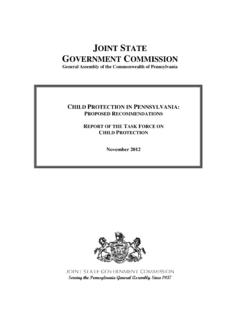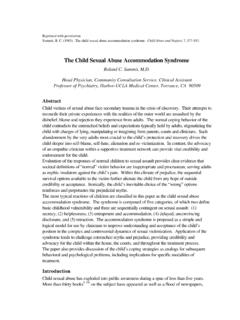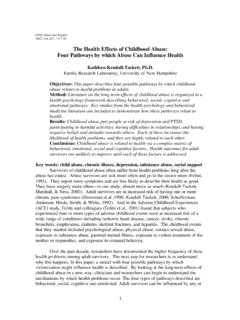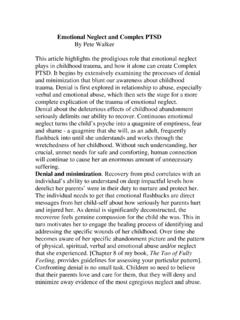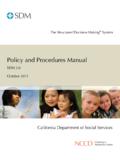Transcription of Pennsylvania Chapter of Children's ... - Child …
1 Pennsylvania Chapter of Children's advocacy Centers multidisci ~ry Teams . , .. -:- 2012 The Multidisciplinary team / Children's advocacy center model For information contact: Alison Gray, PA Chapter Director, 814-431-8151 or at allsongray@ .com Pennsylvania Chapter of Children's advocacy Centers and Multld~sciplinary Teams 5/14/2012 Pennsylvania Chapter of Children's advocacy Centers multidisci ~ry Teams The Children's advocacy center model There was a time when a Child abuse victim was often traumatized by the investigative process of the agencies and people intent on helping the Child . Professionals from Child protective services (CPS), law enforcement, and legal and medical systems interviewed the Child separately and repeatedly in police stations and other environments intimidating to children . These interviews were done to meet the diverse and sometimes conflicting requirements of the agencies involved, rather than the needs of the Child .
2 The victim seldom received the support and services needed. Since 1985, at least 750 communities across the United States have implemented investigation and treatment programs based on the Child advocacy center (CAC) model , first developed in Huntsville, Alabama as the National Children's advocacy center (NCAC). The CAC model promotes an integrated, multidisciplinary, Child -friendly approach to investigation and treatment of Child sexual abuse . At the heart of the model is the multidisciplinary team (MDT) of professionals with expertise in medicine, mental health services, Child protection, law enforcement, prosecution, and victim advocacy . Children's ADYOCACY CENTERS (CACs) are Child -focused, facility-based programs in which representatives from many disciplines work together as a Multidisciplinary team (MDT) to conduct interviews and make team collaborative decisions on cases of suspected Child abuse .
3 The CAC model for Child abuse investigation is proven and effective, bringing together trained professionals to investigate and provide medical and mental healthcare, as well as support to Child victims of abuse , while holding alleged perpetrators accountable through the court system. CAC programs are Child -focused, developmentally sensitive, and designed to create a sense of safety and security for Child victims, thus beginning their restoration to health. Page 2 I M D T a n d C h i I d r e n ' s A d v o c a c y C e n t e r 5 BACKGROUND Although the Child advocacy model (CAC) has existed for more than two decades, many communities continue to provide traditional responses to Child abuse cases. Unfortunately, traditional responses fail to encompass the full array of services, systems, and disciplines commonly involved in the provision of services throughout most CAC communities.
4 In 1988, representatives from Child advocacy Centers (CACs) around the country joined forces to establish the National Network of Children's advocacy Centers. A decade later, in an effort to reflect the Network's national composition and focus, the National Network became known as the National Children's Alliance (NCA). NATIONAL Children's ALLIANCE (NCA) is the national association and accrediting body for Children's advocacy Centers (CACs) throughout the country, dedicated to helping local communities respond to allegations of Child abuse in ways that are effective, efficient, and put the needs of Child victims first. NCA provides accreditation, training, support, technical assistance, and leadership on a national level to over 750 local CACs responding to reports of Child abuse and neglect across the country. The mission of the NCA is to promote and support communities in providing a coordinated investigation and comprehensive response to victims of Child abuse .
5 NCA strives to provide every Child access to the services of an accredited CAC. CACs associated with NCA undergo an accreditation process that follows a regularly updated set of 10 standards established by the NCA Board of Directors to ensure that CACs offer effective, efficient, and consistent delivery of services. The NCA Standards for accreditation require CACs to demonstrate to expert site visitors that the CAC adequately addresses each of the following 10 criteria: 1. Child -Appropriate/ Child -Friendly Facility 2. Multidisciplinary team 3. Organizational Capacity 4. Cultural Competency and Diversity 5. Forensic Interviews 6. Medical Evaluation 7. Therapeutic Intervention 8. Victim Support/ advocacy 9. Case Review 10. Case Tracking The accreditation process ensures that CAC programs adhere to rigorous standards of quality service provision known to be effective in reducing the trauma of the investigations required to foster effective prosecution and in helping children heal from the effects of abuse .
6 To be accredited CACs must follow the standards, yet each community can customize their approach within these standards. As noted previously, the Multidisciplinary team (MDT) is central to the CAC model of coordinating the investigation of suspected Child abuse and the therapeutic response to the Child and family. THE MULTIDISCIPLINARY team (MDT) The multidisciplinary team (MDT) approach to investigating Child abuse brings together the various professions involved in a Child abuse case and fosters their ability to work in a unified manner rather than as professionals working in isolation from one another. The ideal MDT consists of CPS investigators, law enforcement, prosecutors, medical professionals, mental health professionals, and victim advocates. The MDT allows these professionals to develop skills and strategies that: (a) enhance the ability to meet the specific obligations of each of their roles in the investigation of suspected Child abuse , (b) foster closer collaboration and information exchange during the investigative process, (c) reduce the trauma of the Child victim, and (d) create opportunities for evidence collection that promotes justice in prosecution of alleged perpetrators.
7 Page 3 I M D T a n d C h i I d r e n ' s A d v o c a c y C e n t e r s In addition to reducing trauma to children imposed by repetitive interviews, the MDT approach also promotes better assessment of the physical and psychological needs of children and families, resulting in earlier and faster healing for the victim and family members through referral for specialized services. MDTs often obtain more credible evidence than individuals working in isolation, resulting in stronger criminal cases, faster prosecution and, arguably, more plea agreements. By decreasing the need for children to testify in court, the potential of additional trauma to children is further reduced. Equally as important as gathering the evidence that will permit effective prosecution, the MDT approach to Child abuse investigations may also quickly exonerate those who are innocent of the allegations. Thus, the MDT approach fosters the process of justice and accelerates the process of healing.
8 CACs facilitate the collaborative investigations subsumed by MDT approach. The CAC permits forensic interviews to occur in neutral, Child -friendly environments. Research has demonstrated that communities with CACs have a higher coordination rate between law enforcement and CPS than communities without a CACi. FORENSIC INTERVIEWING Within the Children's advocacy center (CAC) model , forensic interviews are typically the cornerstone of a Child abuse investigation, effective Child protection and subsequent prosecution, and may be the beginning of the road toward healing for many children and families. The manner in which a Child is treated during the initial forensic interview significantly affects the Child 's understanding of, and ability to respond to, the intervention process and/or criminal justice system. Forensic Interviewers are responsible for obtaining a statement from a Child in a manner that is developmentally and culturally sensitive, unbiased, and fact-finding.
9 The resulting evidence promotes accurate and fair decision-making by the Multidisciplinary team (MDT) with recommendations about how the case might be handled in the criminal justice and Child protection systems. Forensic interviews are Child -centered and coordinated to avoid duplication. Using this approach, the CAC model reduces systemic trauma imposed on children by eliminating the multiple interviews typically conducted in non-CAC/MDT investigations. Within the CAC model , Forensic Interviews are performed by individuals who have received special training to assure that the interviewing process is neutral (or unbiased), sensitive to the Child 's developmental and functional level, prevents imposing additional trauma, and avoids contaminating the investigative process. CAC cases have more MDT collaboration regarding forensic interviews and fewer interviews of the Child victim than those counties without a forensic interviewer';, The role of the Forensic Interviewer may be filled by a CAC-employed forensic interviewer, law enforcement officers, CPS workers, medical providers, federal law enforcement officers or other MDT members, according to the resources available in the community.
10 However, at a minimum, anyone in the role of a forensic interviewer should have formal forensic interviewer training and continued opportunities for supervision and consultation. CACs play a key role in the recruitment and training of Forensic Interviewers, and they provide a network of peer supervision among local Forensic Interviewers and collaborative consultations with national experts. MEDICAL EXAMINATIONS THROUGH A CAC: How having a CAC helps Page 4 I M D T a n d C h i I d r e n ' s A d v o c a c y C e n t e r s Children's advocacy Centers (CACs) influence the delivery and timing of forensic medical exams, who receives these exams, and the satisfaction of caregivers with these examsiii. Where penetration was disclosed, children served by CACs were times more likely to receive forensic medical exam versus children in the comparison sample. Consequences for children Who Do Not Receive a Specialized Medical Exam Assessment for Sexually Transmitted Infections is not performed and, therefore, children are de prived of treatment for these diseases.

